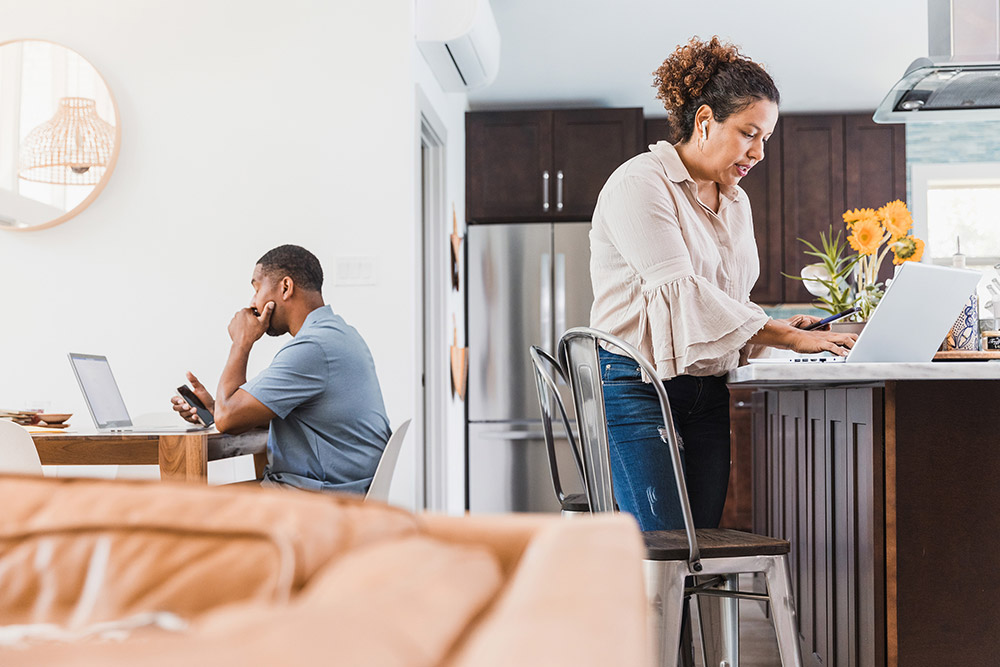两性社交方式在疫情期间大不相同

即使面对疫情,蔡丽•埃尔韦尔依然把生活过得风生水起。她经营着一家品牌工作室,刚刚搬到缅因州,还是设计网络小组的候任领导。
每天她都在Facebook和Instagram上跟所谓“妈妈创业邦”的伙伴们聊天。当中一些人成了她的客户,还有一些人成了她的朋友和介绍人。
和埃尔韦尔不同的是,丈夫道格拉斯主要靠社交网络来和家人或好友叙旧,而不是与陌生人建立联系。
在他看来,“Facebook是用来释放压力的。他是教科书上典型的内向性格。” 29岁的埃尔韦尔说,“在我来看,接触陌生人后获得回应会很有成就感,但他不喜欢那样。”
这对夫妻的表现是典型的例子,从中能够看出疫情期间男性和女性社交方式的不同之处。耶鲁大学管理学教授玛丽莎•金是《社交化学:解码人类联系的模式》(Social Chemistry: Decoding the Patterns of Human Connection)一书的作者。最初她的研究仅着眼于疫情之前,全面封锁后她重新访问研究对象并得到重大发现:人际交往减少了17%,减少的几乎全是男性之间社交。
她说:“问题不在于社交花了多少时间,其实女性比男性的时间少很多。重要的是时间如何分配。”
她概括了两性之间的主要差异,疫情期间人们普遍感到孤独不安的整体趋势,以及雇主和社交网络可以发挥什么作用。
• 男性之间的人际关系更偏向事务性:我为你做事,你为我做事。
• 员工分为两种:能够把工作和家庭分开的人和二者分不开的人。眼下工作与生活分不开的群体陷于极度职业倦怠。
• 视频会议给非语言交际带来极大的压力,或许重要的交流不适合采用这种方式。
• 社交网络越大,孤独感就越小。在公司办公通常有助于降低孤独感、极端情绪和回声室效应,现在更需要发挥积极作用。
男性倾向于建立投桃报李型的人际关系,也就是金称之为“工具式”关系。例如,《华盛顿邮报》(Washington Post)的千禧一代女性专栏《百合》最近用了这样一个标题:“女性找人帮忙会先约咖啡,男性则直接张口。”
根据金的看法,在人际关系中,男性会问:“我可以得到什么好处,我的工作目标是什么?”而“女性社交时则有更多的情感交流。危机期间,情感交流的工具性基础其实比较薄弱。”
疫情期间,女性维持社交方面鲜有好消息。有人生意倒闭。有人丢了工作。有人忙着工作、家庭教育,还要为年迈的父母预约疫苗接种(说的就是“上有老下有小”的一群人),忙得焦头烂额。还有人完全退出了劳动力市场。
讽刺的是,困境原本给女性造成伤害,如今也推动女性互相帮助。女性利用人际交流加强并扩大群体联系。
金说:“男性倾向于一起做事来维持社交,比如一起打高尔夫或在酒吧喝酒。女性则倾向于通过交谈。”
金发现,疫情期间,如果有5个以上亲密联系就不会感到孤独。无论现在还是复工以后,办公室确实能够促进人们之间沟通,从而帮助建立密切联系。
随着本周美国格外关注政治过渡与弥合分歧,公司也要发挥积极作用。金说:“如果说疫情期间社交关系发生了什么变化,就是更加封闭疏离,变得更像回音室。”
有时一些简单的行为就可以带来意想不到的效果。比如,打个电话问候员工,让他们知道自己受到关心,不要总是开视频会议。金说:“如果真想联系,不如改为语音,交流起来效果比视频好得多。”“视频时人们可能想着‘别让自己看起来很沮丧’,结果越发关注自己,却没那么关心说了什么内容。”
员工通常有两种类型,也会影响人际交往。所谓的“区分派”会把工作和家庭分开,这类人往往通勤时间更长,按照不同分类的日程表做事。“综合派”则更喜欢把家庭和工作搅在一起。
对“综合派”来说,疫情让他们很难区分“在工作中生活与在生活中工作”,因为很难划分生活和工作的界限。
这也正是疫情初期恰逢创业的品牌顾问埃尔韦尔遇到的主要问题。“我给自己的压力太大了。”她回顾了当时的状态,“然后我意识到自己正在做很棒的事情,能够全面滋养灵魂,激发了创业精神和创造力,还可以抚育女儿、照顾丈夫和自己。我一定要维持这种平衡。”(财富中文网)
译者:晓维
审校:夏林
即使面对疫情,蔡丽•埃尔韦尔依然把生活过得风生水起。她经营着一家品牌工作室,刚刚搬到缅因州,还是设计网络小组的候任领导。
每天她都在Facebook和Instagram上跟所谓“妈妈创业邦”的伙伴们聊天。当中一些人成了她的客户,还有一些人成了她的朋友和介绍人。
和埃尔韦尔不同的是,丈夫道格拉斯主要靠社交网络来和家人或好友叙旧,而不是与陌生人建立联系。
在他看来,“Facebook是用来释放压力的。他是教科书上典型的内向性格。” 29岁的埃尔韦尔说,“在我来看,接触陌生人后获得回应会很有成就感,但他不喜欢那样。”
这对夫妻的表现是典型的例子,从中能够看出疫情期间男性和女性社交方式的不同之处。耶鲁大学管理学教授玛丽莎•金是《社交化学:解码人类联系的模式》(Social Chemistry: Decoding the Patterns of Human Connection)一书的作者。最初她的研究仅着眼于疫情之前,全面封锁后她重新访问研究对象并得到重大发现:人际交往减少了17%,减少的几乎全是男性之间社交。
她说:“问题不在于社交花了多少时间,其实女性比男性的时间少很多。重要的是时间如何分配。”
她概括了两性之间的主要差异,疫情期间人们普遍感到孤独不安的整体趋势,以及雇主和社交网络可以发挥什么作用。
• 男性之间的人际关系更偏向事务性:我为你做事,你为我做事。
• 员工分为两种:能够把工作和家庭分开的人和二者分不开的人。眼下工作与生活分不开的群体陷于极度职业倦怠。
• 视频会议给非语言交际带来极大的压力,或许重要的交流不适合采用这种方式。
• 社交网络越大,孤独感就越小。在公司办公通常有助于降低孤独感、极端情绪和回声室效应,现在更需要发挥积极作用。
男性倾向于建立投桃报李型的人际关系,也就是金称之为“工具式”关系。例如,《华盛顿邮报》(Washington Post)的千禧一代女性专栏《百合》最近用了这样一个标题:“女性找人帮忙会先约咖啡,男性则直接张口。”
根据金的看法,在人际关系中,男性会问:“我可以得到什么好处,我的工作目标是什么?”而“女性社交时则有更多的情感交流。危机期间,情感交流的工具性基础其实比较薄弱。”
疫情期间,女性维持社交方面鲜有好消息。有人生意倒闭。有人丢了工作。有人忙着工作、家庭教育,还要为年迈的父母预约疫苗接种(说的就是“上有老下有小”的一群人),忙得焦头烂额。还有人完全退出了劳动力市场。
讽刺的是,困境原本给女性造成伤害,如今也推动女性互相帮助。女性利用人际交流加强并扩大群体联系。
金说:“男性倾向于一起做事来维持社交,比如一起打高尔夫或在酒吧喝酒。女性则倾向于通过交谈。”
金发现,疫情期间,如果有5个以上亲密联系就不会感到孤独。无论现在还是复工以后,办公室确实能够促进人们之间沟通,从而帮助建立密切联系。
随着本周美国格外关注政治过渡与弥合分歧,公司也要发挥积极作用。金说:“如果说疫情期间社交关系发生了什么变化,就是更加封闭疏离,变得更像回音室。”
有时一些简单的行为就可以带来意想不到的效果。比如,打个电话问候员工,让他们知道自己受到关心,不要总是开视频会议。金说:“如果真想联系,不如改为语音,交流起来效果比视频好得多。”“视频时人们可能想着‘别让自己看起来很沮丧’,结果越发关注自己,却没那么关心说了什么内容。”
员工通常有两种类型,也会影响人际交往。所谓的“区分派”会把工作和家庭分开,这类人往往通勤时间更长,按照不同分类的日程表做事。“综合派”则更喜欢把家庭和工作搅在一起。
对“综合派”来说,疫情让他们很难区分“在工作中生活与在生活中工作”,因为很难划分生活和工作的界限。
这也正是疫情初期恰逢创业的品牌顾问埃尔韦尔遇到的主要问题。“我给自己的压力太大了。”她回顾了当时的状态,“然后我意识到自己正在做很棒的事情,能够全面滋养灵魂,激发了创业精神和创造力,还可以抚育女儿、照顾丈夫和自己。我一定要维持这种平衡。”(财富中文网)
译者:晓维
审校:夏林
Caili Elwell is living her best life, despite the pandemic. She runs a brand studio, just moved to Maine and is president-elect of a design networking group.
She spends her days on Facebook and Instagram chatting with fellow “mom preneurs,” as she calls them.” Some turn into clients and others become friends and referrals.
Her husband Douglas, on the other hand, views social media as a way to catch up with family or existing friends versus networking among strangers.
For him, "Facebook is something to decompress. He’s the textbook definition of an introvert,” 29-year-old Caili Elwell says. “I consider it a form of an accomplishment if I can get someone to respond to a cold reachout. He doesn’t like doing that.”
The husband-and-wife pair is a classic case in how men and women are networking very differently through the pandemic. Yale management professor Marissa King is author of the new book, “Social Chemistry: Decoding the Patterns of Human Connection.” Initially basing the work on pre-pandemic research, she revisited subjects after the lockdown and made a stark discovery: Networks had shrunk by 17%—almost entirely among men.
“It’s not how much time you’re spending networking. Women have far less time than men do,” she said. “It’s how you spend it.”
She outlines key differences between men and women, as well as the overall disconcerting trend of loneliness in the pandemic and how employers and networks might help.
• Men’s networking tends to be more transactional: I do something for you. You do something for me.
• There are two types of employees: People who can separate work and home, and those who cannot. The latter is contending with steep burnout right now.
• Videoconferences put a lot of pressure on nonverbal communication and might not be ideal for important conversations.
• The bigger the network someone has, the less lonely they are. Workplaces traditionally help counter loneliness, polarization and echo chambers. They need to embrace this role even more right now.
Men tend to build what King calls “instrumental” relationships, classic tit-for tat. Example: The Washington Post’s millennial women’s section, The Lily, recently declared in a headline, “Women ask for coffee, men tend to call in favors.”
“What can I get out of it? What are my workplace goals?” is what men ask, according to King. “Women tend to have much more emotion in their relationship. And it turns out that instrumentality is a pretty weak foundation during times of crisis.”
That women have hung onto networks is a rare spot of positive news for them in the pandemic. They are losing business. They are losing jobs. And they are losing any semblance of balance among work, homeschooling and hitting refresh to schedule elderly parents for vaccines (I see you, fellow members of the sandwich generation). Some are just dropping out of the workforce altogether.
Ironically, the same conditions hurting women right now might be causing them to turn to each other. Networks serve to reinforce community and amplify community.
“Men tend to maintain their social connections by doing things together,” King said, citing golf or drinks at the bar. “Women tend to maintain their ties through conversation.”
Her research finds that people with five or more close connections haven't experienced loneliness in the pandemic. And this is an area workplaces can help foster connectivity, both now and after the return to work.
As the country’s attention shifts this week to political transition and healing divides, workplaces have an active role to play. “If we talk about what’s happened to our networks in the pandemic—they've become more closed and sealed off,” King said. “They've become more of an echo chamber.”
Something as simple as checking on employees to let them know they are not alone can make a big difference. And don’t always make it a Zoom. “If you really want to connect, shifting to voice-only communication will allow you to connect far better than video,” King says. “Video might make you think, ‘I don't want to look like I’m upset.’ It increases focus on the self, versus what’s being said.”
Workers generally fit into one of two categories that are also affecting networking. So-called 'segmenters' keep work and home separate, tend to have longer commutes and maintain separate calendars. 'Integrators' are comfortable with home and work overlapping.
The pandemic—think "living at work versus working from home”—has been especially tough on integrators, who have a harder time setting boundaries.
This was brand consultant Elwell's main problem in the earlier days of the pandemic and launching her business. "It was pressure I put on myself," she says, in hindsight. "Then I realized I am creating this wonderful thing that feeds every part of my soul, my entrepreneurial, creative and provider sides for my daughter, my husband—and myself. I have to protect that."













